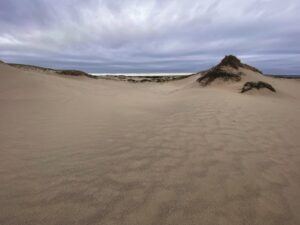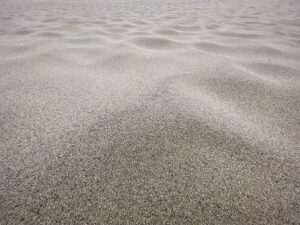The wind blew all night. It rushed in from the northeast, breaking over the peaks and hollows of the Province Lands. It kept me awake with that quality of sound that only wind, rain, or rivers have, constant and at once loud and gentle, like a thousand people whispering at the same moment. It tightened and whistled as it pushed through the tiny squares of the dune shack’s screens. The sand, airborne in the wind, stippled the gray shingles of the shack in grainy bursts.

I had been on the dunes for a few days before the wind came up, staying in a simple, sun-grayed structure nestled among the beach plums and pines. Zara is a little box with a hipped roof that holds a wood stove, a cast-iron two-burner Glenwood, and now a sizable chunk of my heart. I had proposed to the Peaked Hill Trust that I would be there to write. But after being confronted with my own misunderstanding of what that meant, I stopped trying so hard to create something and started watching and listening.
Sheltered from the wind, I looked over the books on Zara’s cedar shelf and pulled down a thin volume with a broken spine and the arcing form of Cape Cod drawn across its faded face behind the words “A Geologist’s View of Cape Cod by Arthur Strahler.”
Strahler’s book was first published in 1966. This copy was a delicate thing, in the process of disintegration. A page dropped to the floor, then a whole chapter slid from between the covers. It felt important to get to hold and read this book in its brief time left before it returned to dust. For a tiny book, it held vast spans of time and information.
Cape Cod, Strahler explains in pleasantly simple language, is only 23,000 years old — a baby in the unimaginably long timeline of geology. It was left as a deposit at the southernmost lobes of the Wisconsin glaciation, a slab of dense ice nearly a mile deep. At the time of its formation, much of Earth’s sea water was held in colossal ice sheets. The coast was at an elevation 400 feet lower than today’s.
The Cape was a jumbled mass of till and glacial outwash left on high ground, a sandbar above the water line at low tide. As the ice melted and the geologic tide rose, the wind, the waves, and the currents began the patient work of the sculptor, softening the Cape’s eastward edge, wearing it smooth. The form we know, the Cape’s elegant, coursing arc with its wisps of curled sand at north and south, was achieved only in the last three to five thousand years.

Ten thousand more years. That is how long the Cape has before the tide fills in. The waves and currents will draw her thin and spread her to scattered bars. The wind will blow her, one grain at a time, to some other place. She will return to the same water that formed her, then ice, now ocean.
Reading Strahler by lantern light, I felt I was learning a few words of a new language that was being spoken all around me. The dunes and the beach, the wind and the currents, were in a conversation I now felt the gist of. In Strahler’s science were the wonders of the world, magnified.
In the morning, the dune grass waved slowly, drawing short arcs in the sand. Rippled sand banks lay in repose like snow drifts across yesterday’s trail. Familiar footprints and tracks were smoothed and lost. Last night and today were a moment’s glance into an eternal process.
The beach was made new. Sand that had lain undisturbed for the last eight million nights had been pulled by the waves from its long rest and spread out under the light of the sun. The evening before, the beach had been a wide, gentle summer slope. Now its profile was cupped, the crest of a waist-high cliff running parallel to the water the only evidence of its previous outline.
A little sandbar had formed off the beach. A thin, graceful wisp of sand where two side-shore currents met and turned seaward. The currents drew the loose sediment from the beach into a fine compass arrow pointing north. Ripples bunched and hollowed over the bar, casting their shadows through clear water onto the pale sand below. The tide came in, and the little bar disappeared beneath the waves.



